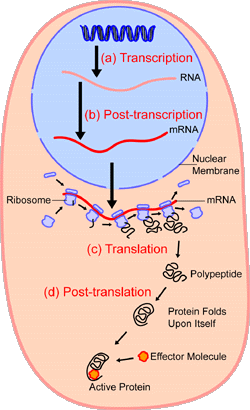Protein biosynthesis
|
|

Within the nucleus of the cell (light blue), genes (DNA, dark blue) are transcribed into RNA. This RNA is then subject to post-transcriptional modification and control, resulting in a mature mRNA (red) that is then transported out of the nucleus and into the cytoplasm (peach), where it undergoes translation into a protein. mRNA is translated by ribosomes (purple) that match the three-base codons of the mRNA to the three-base anti-codons of the appropriate tRNA. Newly synthesized proteins (black) are often further modified, such as by binding to an effector molecule (orange), to become fully active.
Protein biosynthesis is the process in which cells build proteins. The term is sometimes used to refer only to protein translation but more often it refers to a multi-step process, beginning with transcription and ending with translation. Protein biosynthesis although very similar, differs between prokaryotes and eukaryotes.
| Contents |
Transcription
Main article: Transcription
Transcription only requires one strand of the DNA double helix. This is called the coding strand. The transcription starts with initiation. RNA polymerase, an enzyme, binds to a specific region on the DNA, marking the starting point, called the promoter. As the RNA polymerase binds on to the promoter, the DNA strands are beginning to unwind.
The second process is known as elongation. As the RNA polymerase travels through the strand that is opposite to the coding strand (the cell wants a copy of the coding strand, so it needs to copy that from the DNA that is the opposite of the coding strand), it matches corresponding mRNA nucleotides to the DNA.
As the polymerase reaches the termination stage, modifications are required for the newly transcribed mRNA to be able to travel to the other parts of the cell, including cytoplasm and endoplasmic reticulum. A 5’ cap is added to the mRNA to protect it from degradation. A poly-A tail is added on the 3’ end for protection and as a template for further process.
Translation
Main article: Translation
During translation, the message of mRNA is decoded to make proteins. Initiation and elongation occur when the ribosome recognizes the starting codon on the mRNA strand and binds to it. The ribosome has sites, which allow another enzyme, tRNA to bind to the mRNA. On tRNA, there is an anticodon that is used to match the codon on the mRNA. tRNA also has a single unit of amino acid attached to it.
As the ribosome travels down the mRNA one codon at a time, another tRNA is attached to the mRNA at one of the ribosome site. The first tRNA is released, but the amino acid that is attached to the first tRNA is now moved to the second tRNA, and binds to its amino acid. This translocation continues on, and a long chain of amino acid (protein), is formed.
When the entire unit reaches the end codon on the mRNA, it falls apart and a newly formed protein is released. This is the termination. It is important to know that during this process, many enzymes are used to either assist or facilitate the whole procedure.
Events following biosynthesis
The events following biosynthesis include protein folding and post-translational modification. During and after synthesis, polypeptide chains often fold to assume, so called, native secondary and tertiary structures. This is known as protein folding.
Many proteins undergo post-translational modification. This is may include the formation of disulfide bridges or attachment of any of a number of biochemical functional groups, such as acetate, phosphate, various lipids and carbohydrates. Enzymes may also remove one or more amino acids from the leading (amino) end of the polypeptide chain, leaving a protein consisting of two polypeptide chains connected by disulfide bonds.
See also
External links
- Protein Synthesis (http://www.accessexcellence.org/AB/GG/protein_synthesis.html)
- DNA Workshop (http://www.pbs.org/wgbh/aso/tryit/dna/)de:Eiweißsynthese
es:Síntesis proteica eo:Proteina sintezo fr:Synthèse des protéines nl:Proteine biosynthese ja:翻訳 (生物学) pl:Biosynteza białka
